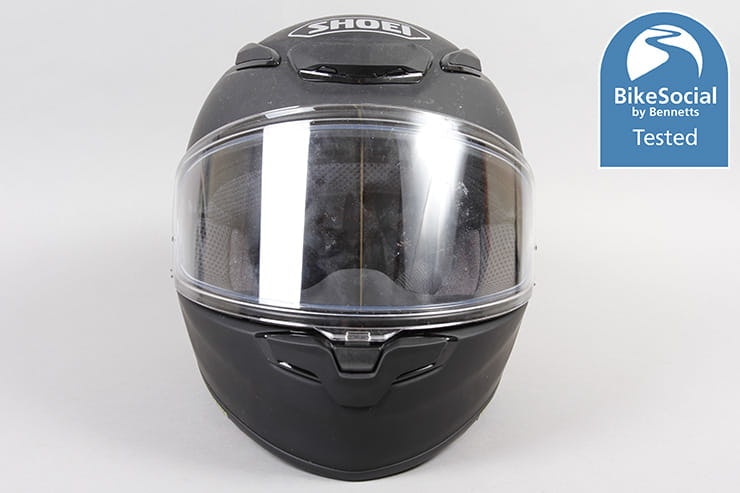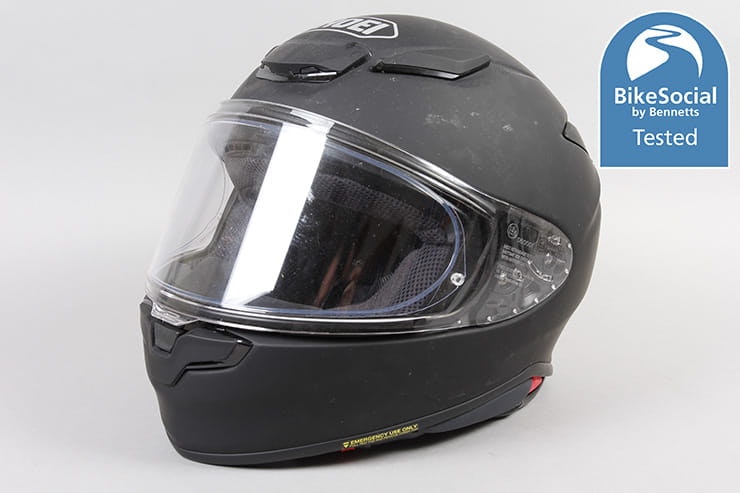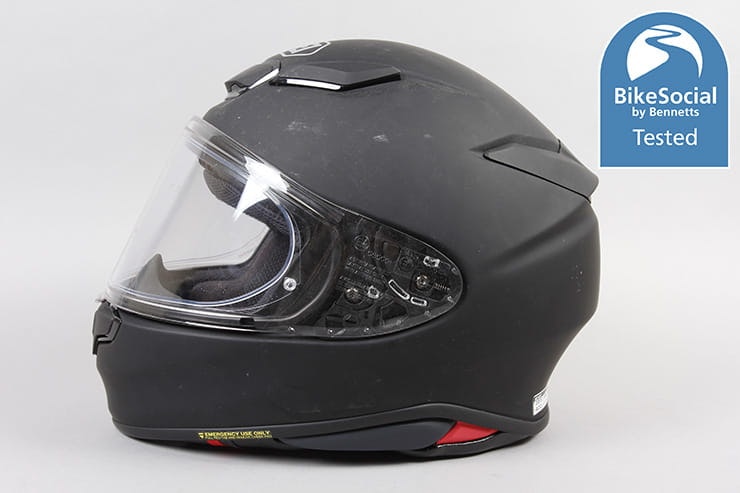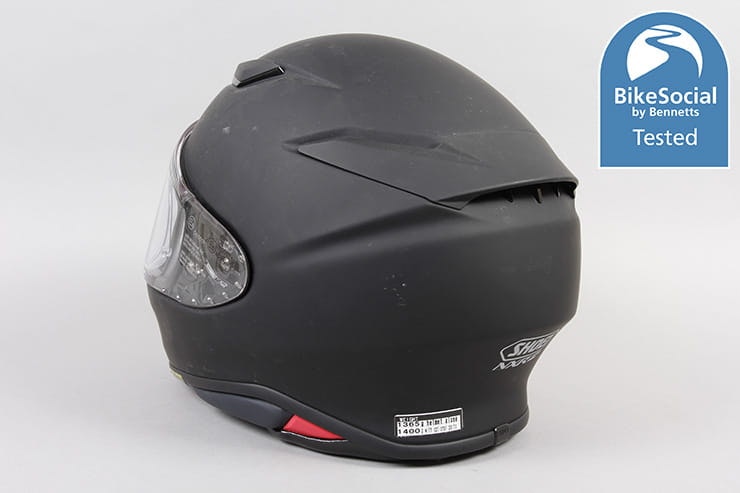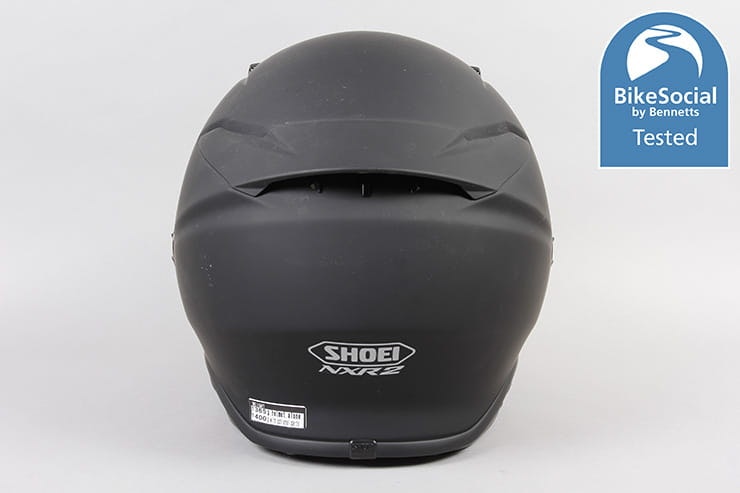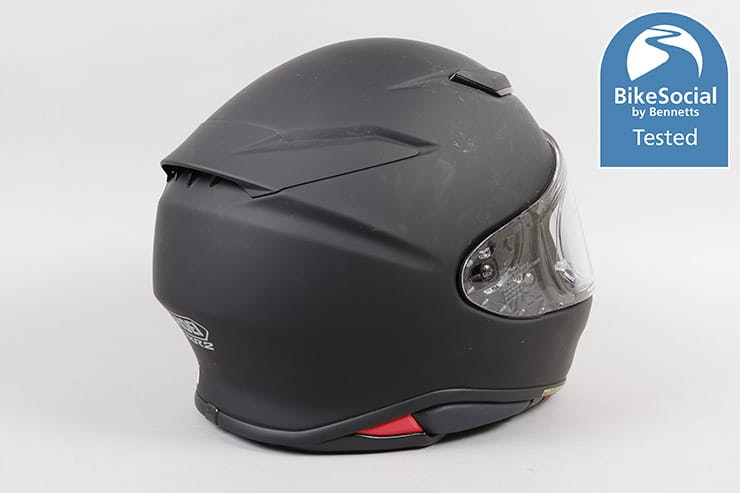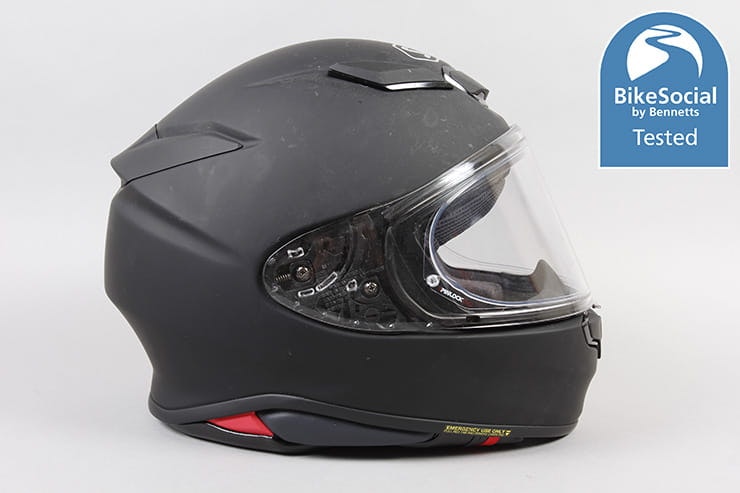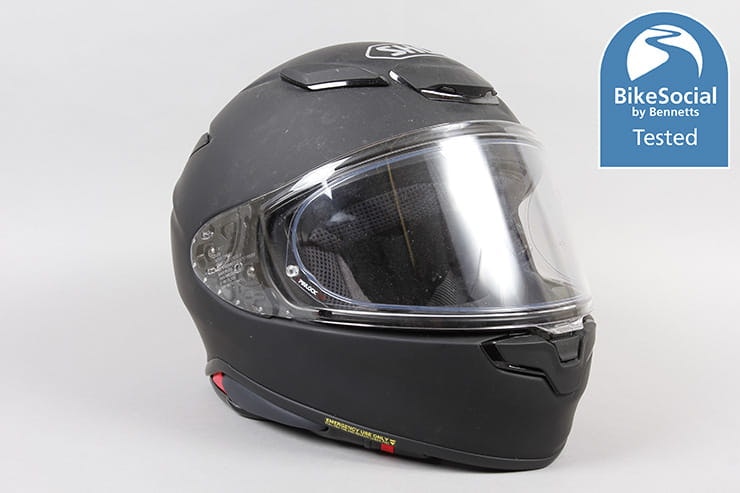Shoei NXR2 review | ECE22.06 helmet tested
By John Milbank
Consumer Editor of Bennetts BikeSocial
28.01.2022
Date reviewed: August 2021 | Tested by: John Milbank | RRP: From £429.99 | www.shoeiassured.co.uk
When Arai released the Quantic, the fact that it was the first to have ECE22.06 approval meant it was – technically – the safest helmet you could buy. But now there’s a very real contender in the Shoei NXR2 on review here.
The current 20-year-old ECE22.05 standard provides a minimum safety level that helmets must meet, whereas ECE22.06 demands a lot tougher testing at a wider range of speeds, on far more (a total of 18 now) points of impact and a new ‘oblique’ test, which sees the helmet dropped onto a 45° anvil to measure the rotational forces transferred to the brain.
By January 2024, all new helmets sold will have to meet ECE22.06, and while it’s impossible to know how that will shape the market for now, it’s clear that the tougher tests can give you even more confidence in the helmet you buy.
I’ve been wearing the Shoei NXR2 (known as the RF1400 in America) for the past few months on a BMW S1000XR, a Yamaha Tracer 9GT and a Kawasaki ZX-6R to find out if it’s worth the money…
Meets the new, tougher ECE22.06 standard
Excellent aerodynamics
Universal intercom fitting
Visor won’t stay cracked just open
Some might want a drop-down sunshield
Outer shell
Seen here in matt black, which retails at £449.99, the NXR2 starts at £429.99 for white or black, and tops out at £539.99 for graphics.
While I’m not a big fan of matt paint on lids, the outer shell has the excellent construction and finish that you’d expect of a top-end premium helmet manufacturer like Shoei, which was the most popular helmet brand – by a long way – in our survey of 2,133 BikeSocial members, which you can watch here.
Like most top-end lids, the shell’s made of a composite fibre with four different outer shell sizes across the range – one for XXS to S, one for M, one for L and one for X to XXL. That makes it more expensive to construct (and to put through ECE testing), but it does mean someone with a smaller head doesn’t have a massive lid that’s got to accommodate a plus-sized dome.
Shoei NXR2 weight
Claimed to be 1,365g, my medium tipped the scales at just 1,392g (1,485g with a Sena 50R intercom fitted).
To be honest, you’d never feel the difference between this and, for instance, the Arai Quantic (the only other ECE 22:06 lid at the time of writing) when they’re on your head, and I can’t think of any premium lids that I’ve used that do feel heavy. Drag can be the real cause of neck strain, but the Shoei is extremely well designed, cutting through the air even when you’re well up out of the bike’s screen; facing forwards or twisting my head for a shoulder check, there was no noticeable drag at all – the aerodynamics really do seem excellent.
Ventilation
The chin, forehead and two top vents all have two positions and closed, while the rear exhaust is always open.
The controls are easy to operate with gloved hands, though the top vents are a little trickier to set in a middle position – they tend to slide to fully open or fully closed.
The venting is very good, though I do occasionally feel more of a ‘hot spot’ where the wind can blast to points on the head, rather than flowing over your skull. Some people will prefer this very direct ventilation, but I find it doesn’t offer quite the same feeling of air moving all around the lid that some can. There’s plenty of air movement, but the NXR2 isn’t quite the benchmark, at least on my head.
Visor
The visor of course offers additional ventilation, and it’s great to have a central tab, which makes it far easier to pop open when you’re sat in traffic. Unfortunately, as you get up to speed I’ve found that the NXR2’s visor tends to shut itself through wind pressure or even harsh bumps on a firmly-damped bike, so if you’re in a hot climate wanting to ride with the visor cracked open a little, you could struggle.
I really am a fan of central visor tabs, and while there is a new lock built into this one, it’s no bother to release as you swipe your thumb up – using just one digit presses the release as you lift the visor. I’ve no problem with it.
A Pinlock Evo is supplied, which offers the same top-end performance of these anti-mist inserts as the Pinlock 120, so fogging shouldn’t be an issue for most riders. Remember though that these do have a limit – if it’s mid-winter and you’re breathing heavily with all the vents shut, it will still eventually mist up.
The visor – which has an eight-position ratchet – is a new design, so you won’t be able to use one from other Shoeis, including the original NXR.
The NXR2’s visor is easy to remove and replace with no tools, and there’s a small adjusting lever on either side of the mounting plates, which pulls the visor tighter to the seal when it’s rotated to the lower position.
Like the Arai Quantic, the NXR2 doesn’t include a drop-down sunshield; something that doesn’t bother me too much, but you do need to be aware of.
When I first got this helmet, I noticed some water ingress at the top-edge; when the visor was fully shut it would lift away from the seal in the middle, letting rain trickle in during severe weather. I tried the levers, then attempted to adjust the mounting plates, but I couldn’t set them correctly. I contacted Shoei direct, who adjusted it quickly and easily, totally curing the issue.
Steve Rose also has the same helmet and had no issues, so this was clearly a glitch. It’s unlikely others would have a problem, but it can be solved very quickly by your dealer.
Lining
Easy to remove and refit, plush and well finished, the lining is typical Shoei, and it all comes out for cleaning, including the neck-skirt.
The cheek pads are quite small, which can make tucking intercom cable out of the way a little tricky, but it’s great to see that the NXR2 doesn’t push you down the route of having to use Shoei’s own intercom system; as good as it is, many people will want to use what they already have.
Inserts can be popped out of the inner shell to accept speakers easily, and while you can’t use a clip-on intercom bracket thanks to the wide neck sections, there is space to stick one on the side between the ridges moulded into the shell; I have a Sena 50R on there at the moment.
The cheek pads are removable in an emergency to make it easier for responders to safely take the helmet off without disturbing the neck, and I do appreciate the Shoei design, which has clear red straps that are always to hand, but never get in the way.
Fastening
The NXR2 is secured with a traditional double-D strap. This guarantees a secure fit every time, though it’s not something you can easily use with gloved hands.
Fit
Fit is very subjective, but I’ve found the Shoei NXR2 to be very good, if a fraction tighter than some on my forehead.
If you’re shopping for an ECE22.06 helmet, the Arai Quantic is one of the main competitors to the NXR2, and the ease with which the two can be put on and taken off is very noticeably different; the Arai has a wider opening, meaning it requires a lot less effort to push your head inside; the Shoei feels more of the sporty design, your head popping inside more than sliding.
The NXR2 feels very secure when fitted, helped no doubt by the outstanding aerodynamics that mean it suffers very little drag, so as with all helmets, simply be sure to try it on and check it’s snug, without any pressure points. I can confirm that it works fine with spectacles.
Noise
Not one helmet I’ve tried in more than twenty years of product testing has been quiet enough to not need earplugs at anything over about 40mph.
The Shoei NXR2 is no different, and while it’s the screen and fairing that cause the buffeting that’s generally the biggest issue, the aerodynamics do help this lid. It’s very good, though it seems to transmit a fraction more turbulence noise on the buffety Tracer 9 GT than some when tried back-to-back.
For more information on why earplugs are vital with any helmet, and advice on which are the best, click here.
Three alternatives to the Shoei NXR2
This is a high-end helmet with a high-end price, and there’s plenty of competition, but not many that meet the tougher ECE 22.06 standard…
Arai Quantic (from £499.99). It’s more expensive than the Shoei, and despite its large rear wing I’d consider it to be slightly more touring-friendly than the NXR2 thanks to its larger neck opening. The visor catch can be fiddly, the wing makes storing it in luggage more awkward and the neck skirt can’t be removed for cleaning, but the ventilation is superb.
The HJC RPHA 11 Carbon is a high-spec helmet considering it costs from £349.99, though it does have its quirks. You can read the full review here.
For the most practical day-to-day helmet, consider a flip-front. We’ve reviewed plenty of them, and the Shoei Neotec II is great. It starts at £519.99, and you can only use Shoei’s own (excellent) intercom, but you can read the full review here. However, the new Schuberth C5 is proving to be outstanding, with a full test coming very soon.
These are just three of many alternatives – you can find all the helmets we’ve tested here.
Shoei NXR2 review: Verdict
The NXR2 is – technically – the safest Shoei you can buy thanks to its ECE22.06 approval, and one that just seems to glide through the air, causing no noticeable neck strain. I’m delighted to see it being so compatible with any intercom (not just Shoei’s own), and the central visor catch is great, especially for commuters.
Riders are faced with an interesting choice now – snap up the outgoing ECE22.05 models, or choose a helmet that’s passed much more rigorous testing and is proven to meet the toughest safety standards. If you’re looking for a new lid, the new Shoei NXR2 should be up there at the top of your shortlist.
Second opinion: Steve Rose
Shoei’s original NXR has been my go-to helmet for most of the last five years. I like the simplicity; it’s light, comfy, easy to swap or clean the visor, has excellent ventilation and a simple secure fastener. There’s no drop-down visor, no Bluetooth faffing and an absolute confidence that not only would it protect me as well as anything else should bad things happen but, more importantly, while good things are happening, I am comfy, fresh and able to concentrate on all the stuff that makes biking brilliant.
So, the NXR2 has a simple brief; do all the above as well or better without the whiff of five years’ dried-on bodily fluids and decaying insect debris.
Mostly, that’s what it does. This NXR2 weighs around 50g more than my NXR and fits just as snugly – I’d give it an easy 9.5/10 on the unofficial Steve Rose Snuggly scale – as the old one with no pressure points or niggles right from the off. The front centre vent is easier to use in winter gloves and not having a control to open/close the rear exhaust means not having to worry about whether it’s open or closed. Which of course doesn’t matter, because if you have the vents open you need the exhaust open and if the vents are closed there’s nothing coming out of the exhaust anyway. Seems logical to me.
In use there are two significant differences between the NXR2 and the original. First, the good one. The new increased aperture makes a noticeable difference to your field of vision. Looking ahead in a straight line you are aware that there is nothing in your peripheral vision. No dark outlines, no Pinlock pins, just as much of the road ahead as your brain can handle.
When you look behind the benefits are even greater. You can see more for less effort. Riding a sports bike last week in January wearing multiple layers of thermal kit was a doddle. Normally getting a decent look behind when doing a lifesaver in those circumstances needs a lot of straining and little success. In the NXR2 it’s like being in one piece leathers in summer.
The second difference, which is less good (for me at least), is the new central locking clip on the visor. In 31 years wearing Shoei helmets I’ve never ever had visor fly open at any speed. Their previous mechanism worked perfectly even after 40,000 miles of neglect.
Moving the tab to the centre makes it ever-so-slightly harder to locate because it doesn’t stick out as far, and having to push a button in winter gloves with one finger and then flick the visor up with another adds fiddle to something that used to be simple.
Shoei’s version of this is a whole lot better than the last time I tried it on an AGV, but it is still fixing a problem that to my mind never existed.
Thankfully, because the vents are so good and the Pinlock works so well, you don’t actually need to lift the visor that often (unless you wear specs). It’d be one of those ‘how did that wasp get in here’ moments that proved the real test when you need to get the visor open very quickly. Make sure you use the supplied chin curtain and hopefully you’ll never have to test it.
Steve Rose has had the original NXR for four years, before upgrading to the new NXR2
